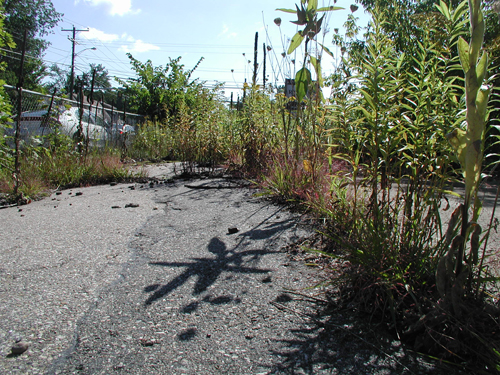Cryptoforestry. Say it aloud once, you won't be disappointed. It sounds like spies should be implanting sensitive information into the DNA of trees to be later decoded by their colleagues, or that some pine farmer is planting his trees in specific patterns only to be deciphered by the satellites above.
Admittedly, the beautiful neologism sounds more attractive than the actual meaning. In the shadows and forgotten corners of urban development, a weedy revolution is taking place. Trees, grass and wild flowers sprout from the cracks of old pavement and forlorn planters. Young saplings push through the checkered, linoleum tiles of some condemned gas station without the aid of human hands, slowly pulling the property back into the forest. These feral patches of trees and plants are cryptoforests, once developed and maintained areas, now languishing, overlooked and hidden in private ownership, are slowly reverting back to the vegetative constant of the environment. When it has the chance, nature finds a way.
Considering Manchester's lengthy history it's surprising that the city doesn't have more cryptoforests, a testament to the city's developmental abilities and entrepreneurism (Detroit might be another story), but I've spied a few. Beyond the South Manchester Rail Trails, is a rich and large cryptoforest sprouting with unnatural looking dogwoods, weeds and pines between and behind old industrial buildings, half of which look abandoned. Underneath an overpass on Elm street, plants and small trees, with a more water based nature, overgrow an abandoned railroad line, fenced off from the human interaction. The Union Leader recently published a short article about the old gas station and the maturing cryptoforest on the corner of Lake Ave. and Hanover St., ruling it an eyesore.
It's easy to condemn these botanical reclamations of space, but after briefly wandering through the lot on Hanover and Lake, I was surprised by the unexpected and eerie beauty of the whole thing. I felt like I was exploring the ruins of a distant, post-human future while the endless rumble of motors beyond the weathered chain-link fence mired me in the present. I was also surprised by how large the space felt once inside its confined forest, with all it's new nooks and crannies to explore.
The ecology of the cryptoforests are also kind of curious. What are considered weeds or invasive plants, tend to be the first to pop up, like hard to kill marines, overtaking the area and exploiting every crevice in the pavement and other structures before the calvary of larger trees and bushes arrive. It's funny to think of weeds as mother nature's botanic foot-soldiers.
Have you seen a cryptoforest in Manchester? Send pics to daniel dot brian at gmail dot com and I'll post a few here in the near future.
Further reading: Cryptoforestry blog
The ecology of the cryptoforests are also kind of curious. What are considered weeds or invasive plants, tend to be the first to pop up, like hard to kill marines, overtaking the area and exploiting every crevice in the pavement and other structures before the calvary of larger trees and bushes arrive. It's funny to think of weeds as mother nature's botanic foot-soldiers.
Have you seen a cryptoforest in Manchester? Send pics to daniel dot brian at gmail dot com and I'll post a few here in the near future.
Further reading: Cryptoforestry blog








2 comments:
Dogwoods sounds like there was a house there once - they're more typically a home garden planting than a commercial landscaping one, though I've seen them used for that more recent years instead of crabapples and Bradford pears.
(Feral sunflowers are not terribly uncommon around here either in the summer, down back alleys & parking lots - bird feeders seem to be the starter mechanism for them.)
Oh, and here's a pretty good pic of the beginning of the end, from last weekend: http://twitpic.com/6d5xa8
That rail trail is probably the subject of my next post (i'm writing three at once). It's a grab bag of flora in those areas beside the abandoned lines. It really makes me wonder how of that sort of flora would be there without the previous development.
Post a Comment